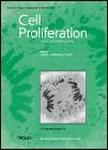版权所有:内蒙古大学图书馆 技术提供:维普资讯• 智图
内蒙古自治区呼和浩特市赛罕区大学西街235号 邮编: 010021

作者机构:Christie Hosp Paterson Inst Canc Res CRC Epithelial Biol Grp Manchester M20 4BX Lancs England Univ Leipzig Inst Med Informat Stat & Epidemiol D-7010 Leipzig Germany
出 版 物:《CELL PROLIFERATION》 (细胞增殖)
年 卷 期:2000年第33卷第4期
页 面:231-246页
核心收录:
学科分类:0710[理学-生物学] 07[理学] 071009[理学-细胞生物学] 09[农学] 0901[农学-作物学] 090102[农学-作物遗传育种]
主 题:细胞计数 细胞分裂 细胞运动/生理学 角蛋白细胞/细胞学 角蛋白细胞/生理学 动力学 小鼠 近交DBA 物理刺激 时间因素 动物 男(雄)性 小鼠
摘 要:It was our objective to obtain an insight into the details and dynamics of the cell proliferative changes following minor barrier disruption, the mechanisms of recovery, and their regulation. Hair of the dorsal area of DBA2-mice was removed and the epidermis was tape stripped. Tritiated thymidine was injected into groups of mice at daily intervals thereafter. Labelling and nuclear densities were measured at several time intervals later in the various epidermal strata to characterize cell production and cell fluxes through the tissue. A dramatic proliferative response was observed at 24 h when the labelling density increased more than sixfold in the basal layer. Labelled cells rapidly appeared in suprabasal layers within a few hours in large quantities while this process took over 2 days in normal skin. Some cycling cells were also found in the suprabasal layer (pulse labelling at 24 h) in contrast with the controls. The cellular flux through the suprabasal layers was drastically (20-fold) increased and the transit time was shortened. Although the nuclear density in the basal layer showed only moderate changes it increased four-fold in the suprabasal layer within 5 days. A kinetic model analysis suggested that the cell cycle time of proliferative cells dropped from a normal value of about 200 h to less than 12 h post tape strip, After 7 days, the proliferative activation still persisted, even though at 3 days post tape strip the stratum corneum had been reestablished. Hence, a mild mechanical alteration with removal of some parts of the cornified layer in mouse backskin epidermis triggers a huge proliferative response with massive overproduction of cells that lasts at least 7 days. Our findings suggest that the re-establishment of the cornified layer does not immediately shut down cell proliferation and that more complex, slower (long-term) regulatory processes are involved.